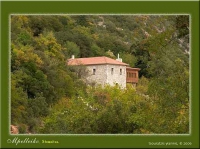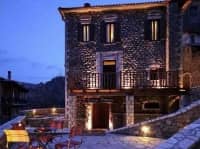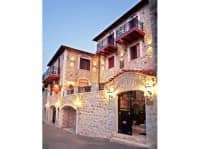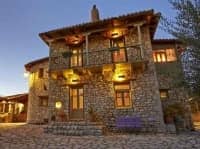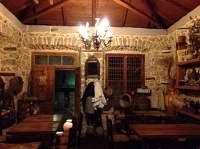The Castles of Arcadia
If you wish to combine your exploration with a specific goal in mind, a visit to a castle could be one of the best choices. The Peloponnese is dotted throughout with ruined castles, most of which are ruined cairns that once prevailed on the summits of hills or mountains and surveyed their surrounding region. Often it was more a matter of temporary fortified positions (and it was for this reason that they did not stand the test of time) rather than an organized fortified compound.
In the Peloponnese, most of the castles were built during the Byzantine years and many during the period of Frankish rule. In several instances, these positions were developed close to or even on top of the ruins of ancient citadels. This is due to the fact that the strategic positions of surveillance, those which follow the morphology of the land, usually do not change even after the passing of millenniums.
Something that makes our visit to a castle even more interesting is the effort itself in arriving there. Built in positions regarded as inaccessible, with access usually only through one place, and now by footpaths that are being slowly erased by time, all this creates conditions that make our excursion exciting and at the same time exhausting. All the more so, however, is our effort rewarded at the end by our satisfaction at “conquering” the castle – an objective as much as for the beautiful images that we will enjoy and the historical memories that awake inside us.
Built in high places, most of the time with an endless view of the four points of the compass, they emit from their ruins a mysticism and a strange charm. As we walk among the ruins and the total serenity of the surrounding nature, simply the thought that once on the very same place lived, struggled and were killed fighting, simple men and soldiers, creates a unique sentiment and mood for contemplation. In particular, if we have read earlier the history of each castle, the actual history and also the myths and legends that go together, then this too makes such thoughts even more intense.
In Arcadia, nearly every summit of a mountain or hill has remains of such fortified castles. EG tries to visit most of the important (in our opinion) castles and relay to you our experiences and their images, and this is the result (the following refers mainly to castles and not to ancient citadels).
For a list of all the castles in Arcadia see here and to see them on a map here.
Oriontas Castle: The Byzantine Castle of Oriontas or Reontas is situated NW of the mountain plateau of Paliochora, bordering North and South Kynouria at the summit of Mount Oriontas. Here were also found stone tools of the Neolithic epoch. We reach it after hiking for 75 to 90 minutes on a trail that heads southeast, through the grounds of the Monastery of Karya.
Castle of Oria at Gardiki: From Tourkolekas of Phalaisia, the road of 7km (mainly dirt road) leads us to the foothills of the sheer rock on top of which the Byzantine Castle of Oria stands. A rough footpath of 1.5km (20mins) takes us to whatever remains are left of the legendary castle.
Castle of Oria at Astros Kynouria: Close to Saint Ioannis Kynouria and on a conical hill at the location of ‘Ksirokabi’, we can see the ruins of the Frankish Castle of Oria. Of the castle, remains of the fortified courtyard, gateway and a tower have been saved.
Palaiochora Castle: At Kaltezes. We start the difficult exploration of the Byzantine castle-state, which numbered more than 2,000 inhabitants from the Monastery of Kaltezes. At the summit of the hill, we can see the ruins of the castle. The signs of the fortifications from the epoch of Ancient Sparta are visible.
Little Castle of Zangoli: From [Kastanitsa][TID:23895 and [Sitaina]Sitaina, we go down Koutoubou’s stream to the right (150m after Loulougka stream), towards the Gorge of Zarbanitsa, high up on the rocks of the left bank we can see, after a tiring ascent, the little Byzantine castle and the small Church of the Virgin Mary of Zangoli.
Goulas Castle: The ruins of the fortifications of the Castle at the summit of Goulas Hill at Nestani. To reach there, we follow for 45mins the rough footpath that starts to the right of the final turn towards the gateway of the Monastery of Gorgoepikos. Take care as it is steep and the surface is unsound.
Ai-Giannis Castle Skortes: Leaving Kourounio: in the direction of the road for Andritsaina, we make a left onto the dirt road towards Psli Panagia and Agiorgi (left at the junction). Parking at the bottom of the hill, it is a 30mins ascent to the summit, the location of the Frankish Castle of Skortes.
Karytaina Castle: The Frankish Castle of Karytaina, at the summit of the hill, was one of the most noteworthy fortresses of the Peloponnese during the periods of Frankish rule and Turkish rule. The view from up high towards the valley of Megalopoli is amazing.
Zapheiropoulos Castle: The very beautiful castle at the summit of the ‘Nisi’, at Paralio Astros, was built by the Zapheiropoulos brothers in 1824 on the site of the former fortification (wall of the Aeginitans 424BC, subsequently of the Villehardouins). According to Kolokotronis, it was the only impregnable castle in the Peloponnese.
Chelmos Castle: Remains of the Byzantine Castle of Chelmos, on the hill of Saint Konstandinos (7km dirt road from Skortsinos Phalaisia). Due to its strategic position, the hill had been steadily fortified and due to this, relics have been found here of Mycenaean, Ancient and Medieval fortifications.
Valtessiniko Castle: At the top of Palaiokastro hill, at 1370m above Valtesiniko, we can see the few ruins (cairns) of Frankish fortifications, the oldest mention of which dates back to the 13th century. It is likely that this castle belonged to the barony of Akova.
Saint Athanasios Castle: On the hill SE of Kamara, in Phalaisia, there is located the old settlement of Ano Kamara which was destroyed by Ibrahim in 1825. At the summit of the hill we can some remains of the castle and the ruins of the Church of Agiothanasis (patron saint and protector of the village).
Leontari Castle: Leontari, of Megolopoli, due to its castle was a military centre for the Palaiologus dynasty up to and including the middle of the 15th century. It was conquered by the Ottoman army in 1460. The castle consists of 3 courtyards. We can distinguish, among others, remains of a tower and an arched water tank.
Akova Castle: Akova was one of the baronies founded in the Peoloponnese by Geoffrey of Villehardouin. A dirt road of 3km from Vyziki takes us to the location of its demolished Frankish castle (13th century), which was destroyed by the Turks in the 15th century.
Kokoreiki Poulia: Leaving Raphtis in the direction of Arachova, at the beginning of the ascent, a signpost shows the direction of the 'Venetian Loopholes' Kokoreiki and Raphteiki caves (opposite but unseen from here). They were used as refuges of the inhabitants in periods of persecution.
Argyrokastro Castle: The ruins of the Frankish Argyrokastro at the summit of the hill NE above Magouliana. Following the dirt road towards the ariels, we walk the short footpath towards the summit. From the 1,450m altitude, the view towards the whole of the Peloponnese is fantastic.
Bezenikos Castle: It stretches out on the summit of the rock that covers the south side of Vlacherna. We follow the road towards the Holy Monastery of the Merciful Virgin Mary. Going up to the demolished gateway of the castle starts at the cave of the Virgin Mary Kataphygiotissa (15-20mins).
Ano Davia Castle: From this point starts the steep footpath that takes us to the remains of the medieval Castle of Ano Davia.
Palaiokastro Plaka Leonidio: At about 3-4km on the road from Plaka towards Tsitalia, we can see the signpost of the Archaeological Service for Palaiokastro. The footpath that starts from the road is rather demanding (30mins) and takes us to the summit of the hill and the remains of the castle.
Artikaina Castle: A few metres before our entering Oreino Korakovouni, there goes to the left a dirt road that after 2.5kms leads us to the Castle of Artikaina (fortification of the Byzantine years). We reach the castle on a rough footpath (20-30mins), enjoying the view towards Paralio Astros.
Kapsabeli Tower: The footpath that starts from the last houses in the village, takes us to the summit of the Castle of Kastanitsa, a former Byzantine tower that took its name from the Friendly Society member Kapsabelis. Here, on 27/7/1826, the Kastanitsiotes crushed the raiders of Ibrahim.
Kastraki of Meligou : From Kastraki, on the pine tree covered hill that arises at the exit of Meligou, towards Koutroupha, we can enjoy the view towards the Lake of Moustou and the surrounding area. Here, we can see the little Church of Saint Apostoli and the remains of the fortified walls and a tower house.
Prastos Castle: The Castle-Rock of Prastos below which we can see the Church of the Virgin Mary, which was burned by Ibrahim, and the bust of the conqueror of Tripoli, Manolis Dounias.
Medieval Tower: At the exit from Agios Vasilios towards Platanaki, after 2km we can see on our left an impressive, 12 metre high medieval tower. Archaeologists have located here ancient Glyppia. The polygonal wall of the ancient fortification has been saved.
Paparis Tower: Above the village of Paparis, dominate the ruined Frankish tower built by the Franks to control the road network of the region. We can reach the tower with a difficult 30 minute ascent from the village or by following the route of the map (shown in EG).
Tselepakos Old Tower: Just after the former School in the village of Tselepakos, there starts to our right a short dirt road that takes us up to the hill of Ai-Giannis and the ruins of the Old Tower that controlled the dense road network of the region (probably of medieval times).
Rousis Tower: Following the dirt road from Orchomenos towards the village of Rousis, we can see after the village and in the valley, a half ruined Frankish tower that controlled the region together with those on the summits of the hills Orchomenos and Palaiopyrgos.
Frankish Watchtower: Just before we arrive at the little Church of Ai-Lias at [Loukas][TID:24404, on our right we can find the remains of the watchtower from the years of Frankish rule.
Venetian Paliopyrgos: In the plain of Daras, where the centre of Ancient Nason has been situated, we can see the Venetian Paliopyrgos. Here, in 1715 the army of Asuman Pasha was encamped and attacked by 200 kleftes from Mainalo.
Tower in Palaiopourgos: Crossing through to its northern limit the village of Palaiopourgos, of the Municipal District of Kleitoras in the Municipality of Gortynia, we can see the Church of Saint Georgios and a few metres farther down, the remains of a Frankish tower-watchtower.
Ancient Tower at Tserpho: The signposts of the Archaeological Service along the roads of Tserpho village, in Tyros, direct us (through fields) to the remains (large stones from its foundation) of an ancient tower of the 4th century BC.


